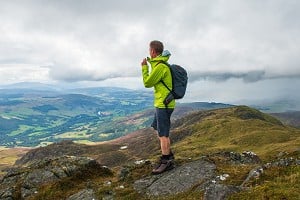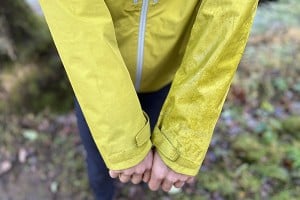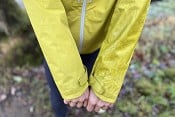
The authors of a forthcoming book on British outdoor clothing (Kickstarting now!) pick out six key pieces of clothing from their research. Garments that contributed to the history of mountaineering and the popular love of the outdoors – and perhaps added a little bit of style.
1. Alpcan duvet 1953
This jacket that went on the 1953 British Mount Everest Expedition is the only item of clothing featured not made in the UK. That's because, in 1953, it seems that there were no UK down clothing manufacturers. Nevertheless, many of the members of that expedition, including Edmund Hillary and George Lowe, were equipped with a 'duvet' down jacket like this.
Alpcan was a French company active from at least the 1930s that made duvets and sleeping bags. The first ever duvet was probably created by an Australian climber, George Finch, as he prepared for the 1922 British Mount Everest Expedition. Reasoning that a coat made of hot-air-balloon material and filled with eider duck down would be both totally windproof and very warm, he had one made to his own design. In 1922 Finch climbed to 27,000 feet (8,321 metres) – higher than anybody had ever previously reached – without frostbite or incident. The duvet concept was initially greeted with derision. But it's very possible that during one of Finch's European lecture tours he passed the idea on to Pierre Allain, the French climbing pioneer, whose experiments then seeded the idea globally in the 1930s.
This particular down jacket was worn by Mike Westmacott on Everest in 1953. Westmacott did not advance very high up the mountain, but played a crucial role in keeping the Khumbu Icefall passable and supply lines open to the advanced camps. He also was chosen to descend with James (later Jan) Morris, the Times journalist, to send the coded telegram that announced Hillary and Tenzing Norgay's success to the world (UKC Article).
Permission to photograph courtesy of the Mountain Heritage Trust.
2. Peter Storm 101, early 1960s
In the early 1960s Peter Storm made some of the first widely available, lightweight waterproof foul weather gear out of PU-coated nylon. It was the brainchild of Noel Bibby, an ex-Royal Marine who dreamt up the Peter Storm name while working in the rag trade in Nottingham. With rolled and glued seams, Peter Storm was cheaper and more cheerful than sailing brand Henri–Lloyd, almost the only competitor at the time. The 'Storm' part of the name was apparently inspired by a TV character; paired with the 'Peter', it created a brand that was approachable and friendly – maybe the first significant outdoor brand of the post-war period.
The iconic Peter Storm design was the 101 cagoule – a word that Bibby brought over into English (in French it simply means 'cowl' or 'hood'). Not having taped seams was always an Achilles heel, as far as weatherproofing went, since water would eventually penetrate via the stitching holes, so by eliminating seams this almost knee-length garment with a quarter zip eliminated areas vulnerable to leaking.
The other Achilles heel of such items was their lack of breathability. As one gear reviewer wrote in 1967: 'The latest fully-proofed nylon rainwear is light and not bulky and is good for walking provided it is loose. I once bought an anorak of this material which was really meant for yachting, and was designed to keep solid water out. It had no ventilation and my clothes were soaked with condensation when I wore it. These light fabrics are scarcely robust enough for climbing, and may be too slippery as well.'
Both of these problems would be solved – to an extent – by the G&H Products CagJac in the early 1970s. It was made of heavier nylon and had a full zip (hence the name) which helped ventilation but compromised the waterproofing.
3. Don Whillans's Mountain Equipment Annapurna jacket, 1970
Peter Hutchinson began making down gear in the early 1960s at the back of a shop in a former brothel in Manchester, before moving to a shack on a farm near Glossop, which he rented out in return for doing chores. 'The whole place was just full of bits of floating bits of bloody feathers and down and stuff, and stank to high heaven,' says Martin Boysen, his friend and eventual member of the Everest 1975 expedition among other mountaineering feats, who spent several weeks dossing down in 'The Shack', as Hutchinson's workshop was known. By the late 1960s he'd made a name for himself, and was encouraged by Bob Brigham to brand his products properly – and Mountain Equipment was born.
Hutchinson, a handy climber himself, had met Don Whillans on the gritstone crags of the Peak District after dropping out of Oxford University and the two remained lifelong friends and collaborators. Hutchinson produced this piece for the 1970 British Annapurna South Face expedition; it was actually part of a double-duvet system, but the one layer proved so warm that the climbers barely used the second.
The successful prototype would form the basis of the company's long-running favourite, the Annapurna jacket.
4. Doug Scott's Javlin pile jacket, 1970s
Insulating layers made out of nylon were pioneered by the Norwegian sailing-gear firm Helly Hansen. In 1961 it created fibrepile (called simply 'pile' by most), a thick, lofty fabric with an open structure that very efficiently trapped warm air around the body and which remained warm when wet – making it beloved of Scandinavian lumberjacks. It didn't make a splash in the UK, however, until the 1970s, when companies including Javlin started selling pile garments to climbers. Set up in Sheffield by a husband-and-wife team, Javlin also found favour among the sailing community and windsurfers, as well as marine and oil-rig workers – which explains the slightly lurid advertising some might remember! The company also sponsored many major expeditions, clothing people like John Porter and Doug Scott in pile, neoprene and wind suits.
This pile jacket was worn by Scott on Everest in 1975, while the photograph shows Scott in a very similar jacket on the ill-fated Ogre expedition in 1977. Pile's moment at the pinnacle of innovation lasted a good while, but in the 1980s it was superseded by fleece, in particular the fabrics made by Malden Mills in the USA that later were branded Polartec.
5. Berghaus Trango Xtrem, 1986
The Xtrem range of outerwear was developed in the mid 1980s by Berghaus with Brian Hall as a key partner. "Just the use of colour, blue, yellow and red was revolutionary," Hall says. "Back then everything was just one monotone blue or green. And so suddenly to have this – the Trango – and the Alpine jacket, and then have a salopette… We developed those three items specifically to take to K2 in 1986, but they then mushroomed and they're still in existence today."
As well as the colour, Hall points to the articulated arms that facilitated climbing movement, to the thicker layers of Gore-Tex at points of abrasion, the multiple harness-friendly pockets and the over-helmet hood as being key innovations.
"Higher up on K2, we used down jackets, but on the approaches and everything else, we used that [the Trango] a lot," he says. "K2 was a marketing aspect and a test bed: it hadn't been released when we went to K2, it was released afterwards."
As for the colours, Hall points to the influence of skiwear, which had begun to percolate into climbers' consciousnesses in the 1970s as winter climbing in the Alps became more popular. But, of course, the colours introduced a fashion element, bringing technical outdoor clothing first to the football terraces and then a more mainstream audience. The Trango is still highly prized by aficionados today.
6. Alison Hargreaves' Sprayway wind suit, 1990s
Early in her career, Alison Hargreaves had worked with Stockport-based female-run climbing brand Calange, but she will forever be associated with the apple green and bright blue of Sprayway, with whom she had a lasting professional relationship. All-in-one windsuits had been around at least since 1975, when G&H Products (later Craghoppers) made them out of spinnaker fabric for Dougal Haston, Doug Scott et al. on that year's triumphant Everest expedition.
Hargreaves took it further, working closely with the brand's designers to make sure the clothing was specifically cut to work for women, and then tested it to the limit, in her groundbreaking feats in the Alps and in the Himalayas. However, in 1995, in the season she was aiming to climb Everest, K2 and Kangchenjunga unaided and without oxygen, she tragically died in a storm while descending K2.

























Comments
Nice article.
Just to add that Helly jackets were quite popular in the 70s but their standard jacket had no pockets or collar. The Javlin had both and was quite a bit cheaper, so really cornered the market for a while.
Shame you did not include a Javlin advert. A friend was at a party in Sheffield 20 years ago and got talking to a middle aged lady who mid conversation let slip that she used to be the " Javlin girl".
I still have my Berghaus Trango Xtrem, great colours! Though I don't use it anymore, it was my first mountain jacket and I loved it.
Think this was the sailing focussed advert rather than the climbing one.
Nice article, iconic pieces. I loved Hargreaves suit back then, the colour combo was a break from the purple, black, burgundy and navy that seemed overpowering.
In Australia in the 1980s, the Trango Extreme was probably the only foreign Gore-Tex jacket available in shops. It was stocked solely by Paddy Pallin (who had their own brand products then) and were $400-500 or so, which at the time here was just ludicrous. Like buying a space suit. I had a blue Peter Storm version of a traditional oiled japara, which most bushwalkers here used, and it was maybe $150.
I look forward to the book, I just can't afford to buy one with postage to Australia. Madness.
Note: First paragraph - 'George Rowe'? Is that from the Peter Sellers audiobook?
The word 'perhaps' is doing some heavy lifting there.
T.